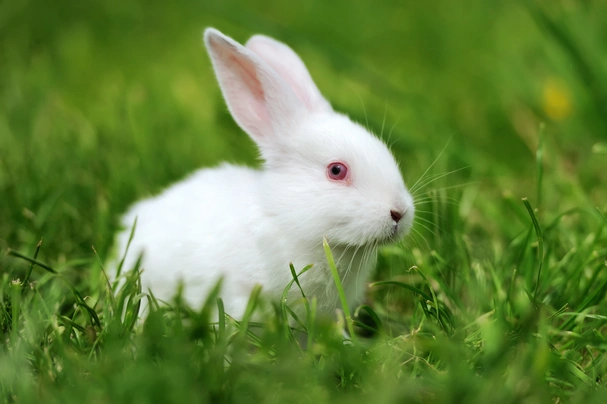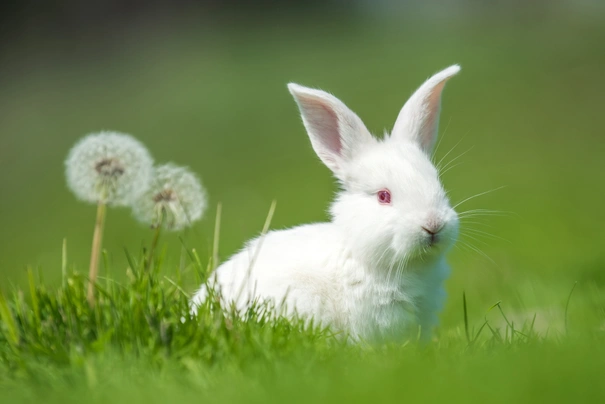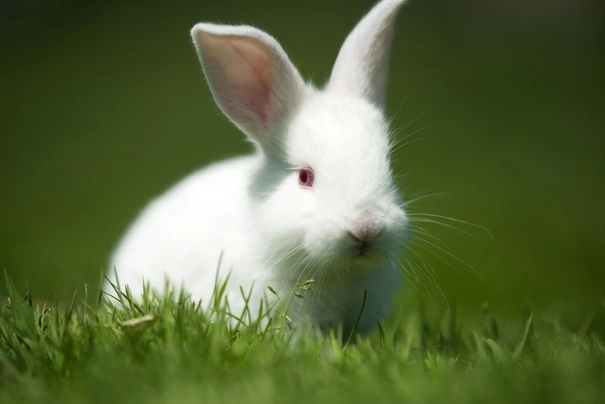Pets
Pets for studWanted petsBreedersAccessories & services
Knowledge hub
Support
Support & safety portalBlanc de Termonde
Introduction of the Blanc de Termonde
This large white rabbit is considered to be one of the rarest breeds in the world and was originally bred in Belgium from a Beveren and a Flemish Giant. The Blanc de Termonde was developed for the meat trade and is currently recognised by the British Rabbit Council (BRC) and the American Rabbit Breeders Association (ARBA).
History of the Blanc de Termonde
Like many other rabbit breeds, the Blanc de Termonde was developed to be a meat animal and to provide food in plentiful supply. By breeding together white examples of the Beveren and the Flemish Giant, a large white rabbit was seen that had finer features than its Hotot and Bouscat cousins. It’s thought that the Termonde made its first appearance in the early 20th Century in France and made its debut in the International shows in Paris in the early decades of the 1900s. As rabbit meat became less popular and other seemingly more attractive breeds such as the Blanc de Bouscat and Angora rose to prominence, the Blanc de Termonde became less prevalent. It is now considered a rare breed.
Appearance of the Blanc de Termonde
- Main colourways: white with pink/red eyes
- Average weight: 4.5 – 5.5kg
The soft, silky fur of the Blanc de Termonde is thick and dense and was highly prized by the fur trade. The Blanc de Termonde is a large rabbit that’s well proportioned, although the doe is finer than the buck and has a pronounced dewlap. The buck has no dewlap whatsoever.
The Blanc de Termonde has a broad, muscular back that has a rounded curve at the rear. The tail is straight and quite long for a rabbit. The coat should be spotless white all over and the eyes should have ruby red pupils with a paler iris. The ears are rounded and must be well covered in fur, giving a feeling of strength and size. They shouldn’t be carried too far apart and the length should be in proportion to the rest of the animal.
The head of the doe is long and fine, while in the buck it takes on a more rounded appearance. The hind legs are muscular and held close to the body and the nails should be white.
Temperament of the Blanc de Termonde
The temperaments of the parent breeds mean this animal is intelligent and playful yet docile enough to make a great pet. Many people say that the Flemish Giants are more like dogs than rabbits – keen to spend time with their owners and clever enough to be trained to recognise their names and use a litter tray.
The Beveren is equally biddable, but will enjoy more active play and exploration. The Beveren side of his personality will need lots of stimulation and plenty of opportunities to roam around outdoors.
Any rabbit will need time to get used to human company and handling and it’s best that gentle interaction begins when he is still young. All rabbits have a tendency to be skittish so getting him used to being around adults, children and other pets while he’s small means he is more likely to remain calm. He’s likely to panic and struggle if he’s picked up when he’s not used to such situations and a struggling adult rabbit can cause injury to both himself and his handler, so getting him used to human interaction early is essential.
Because the Blanc de Termonde is a large rabbit, it may not be the best pet for an inexperienced owner. They require quite a lot of food and produce a large amount of waste, and their housing and general care needs are complex, so careful thought needs to be given to whether or not you can meet those needs on a daily basis should you find yourself thinking about giving a home to a rabbit such as this.
Health of the Blanc de Termonde
Large rabbits like the Termonde naturally carry a little more weight than the smaller breeds but this can mean they are difficult to handle and should only be picked up by a very experienced handler. If the animal is picked up incorrectly or struggles while being held he can injure himself severely and broken backs in rabbits are quite common, particularly in larger breeds that have been handled badly and their backs have been injured by their own bodyweight.
The teeth of a rabbit grow continually so care should be taken to feed him the correct diet (lots of roughage!) and to check his teeth regularly. Overgrown teeth can make eating difficult for your pet and can cause injuries in the mouth.
Respiratory infections such as ‘snuffles’ are also common in rabbits and care should be taken to keep his living area as clean and dust free as possible. He should also be checked regularly for signs of flystrike.
All rabbits should be treated regularly for fleas, ticks and worms and non-breeding females may also be spayed. Uterine cancer in common in rabbits and spaying helps prevent this form of cancer from developing.
Caring for the Blanc de Termonde
As a large, fairly docile animal, the Termonde makes an excellent house rabbit. He will play happily but will also love to sit close by and enjoy a cuddle. Most rabbits don’t really like being picked up, so he will be very happy to simply sit next to you and enjoy your company.
If he is going to live indoors he will need a safe, quiet place he can go for a rest or to get away from it all for a while. A dog crate is ideal for this as, because he is a big rabbit, a special indoor rabbit cage is likely to be too small. He should be taught to use a litter tray, and all cables and wires should be kept out of his way!
If he’s going to live outdoors he should be provided with a weatherproof hutch that’s positioned out of direct wind and sun, or a well-lit, well-ventilated shed. He should also be provided with a large run or secure area of garden where he can exercise and explore.
The hutch or shed should be lined with shavings – hardwood is preferable – and straw so he can nest and burrow. Your pet should also be given a completely covered area where he can retire for a snooze or get out of bad weather. Most hutches have a dedicated nesting area but if he’s in a shed an upturned wooden box with an opening large enough for him to get through will be ideal for nest building. Wherever he lives should be kept clean and must be totally secure to prevent access by predators.
He should be fed good quality hay and rabbit pellets, along with plenty of fibrous green vegetables and he should always have access to clean, fresh drinking water.


